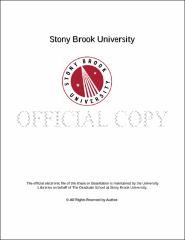| dc.identifier.uri | http://hdl.handle.net/11401/76247 | |
| dc.description.sponsorship | This work is sponsored by the Stony Brook University Graduate School in compliance with the requirements for completion of degree. | en_US |
| dc.format | Monograph | |
| dc.format.medium | Electronic Resource | en_US |
| dc.language.iso | en_US | |
| dc.publisher | The Graduate School, Stony Brook University: Stony Brook, NY. | |
| dc.type | Thesis | |
| dcterms.abstract | Novel methods to build multiple types of three-dimensional structures from various nanoscale components are the most exciting and challenging questions in nano-science. The properties of the assembled structures can be potentially and designed, but the development of such approaches is challenging. In order to realize such rational assembly, a tunable interaction medium is often introduced into the system. Soft matter, such as polymers, surfactants and biomolecules are used to modify the surfaces of the nanoscale building blocks. Deoxyribonucleic acid (DNA) strands are known as polynucleotides since they are composed of simpler units called nucleotides. There are unique base pairing rules that are predictable and programmable, which can be used to regulate self-assembly process with high degree of control. Besides controlling static structure, it is important to develop methods for controlling systems in dynamic matter, with chemical stimuli or external fields. For example, here we study the use of azobezene-trimethylammonium bromide (AzoTAB) as a molecular agent that can control self-assembly via light excitation. In this thesis, DNA assisted self-assembly was conducted. The ability of AzoTAB as a light induced surfactant to control DNA assisted self-assembly was confirmed. The mechanism of AzoTAB as a light controlled self-assembly promoter was studied. In the second project, diffusion of nanoclusters was studied. The presence of polymers brings strong entanglement with nanoclusters. This entanglement is more obvious when the nanocluster is a framed structure like the octahedron in the study. The diffusion coefficient of the octahedron becomes larger during traveling. The following up studies are required to elucidate the origin of the observed effect. | |
| dcterms.available | 2017-09-20T16:49:48Z | |
| dcterms.contributor | Meng, Yizhi | en_US |
| dcterms.contributor | Gang, Oleg | en_US |
| dcterms.contributor | Koga, Tadanori. | en_US |
| dcterms.creator | Lian, Wenxuan | |
| dcterms.dateAccepted | 2017-09-20T16:49:48Z | |
| dcterms.dateSubmitted | 2017-09-20T16:49:48Z | |
| dcterms.description | Department of Materials Science and Engineering | en_US |
| dcterms.extent | 53 pg. | en_US |
| dcterms.format | Monograph | |
| dcterms.format | Application/PDF | en_US |
| dcterms.identifier | http://hdl.handle.net/11401/76247 | |
| dcterms.issued | 2016-12-01 | |
| dcterms.language | en_US | |
| dcterms.provenance | Made available in DSpace on 2017-09-20T16:49:48Z (GMT). No. of bitstreams: 1
Lian_grad.sunysb_0771M_13170.pdf: 3115884 bytes, checksum: dd2afa1c04e499a2f5c0bdcd8be2964c (MD5)
Previous issue date: 1 | en |
| dcterms.publisher | The Graduate School, Stony Brook University: Stony Brook, NY. | |
| dcterms.subject | azotab, Nanomaterials, self-assembly, soft matter | |
| dcterms.subject | Materials Science | |
| dcterms.title | Light-induced Self-assembly and Diffusion of Nanoclusters | |
| dcterms.type | Thesis | |

